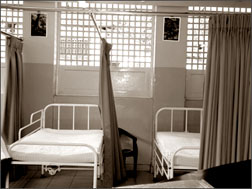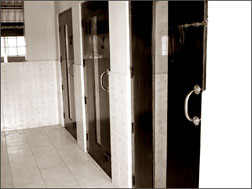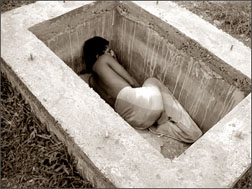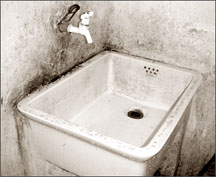From hell to heaven
A long march from lunatic asylum to hospital with a
heart:
by Indeewara Thilakarathne

Remodelled hospital ward |

Patients engaged in creative activities at Rehabilitation Centre
|

Newly partitioned Seclusion Section |

A severly beaten up patient , a common scene of the past |

A traumatized patient hidden in a gutter |

Unhygenic conditions - A scene from the past |
Reminiscent of regalia of the British Empire, a tall elegant building
stands in a strangely spacious land in the suburb of Colombo, Angoda.
The building was constructed by the British as far back as 1929 albeit
it still stands tall amidst host of other buildings that make up the
Angoda Mental (Teaching) Hospital.
The spacious old, colonial style building which houses the main
office of the hospital including that of its director, would have
witnessed the untold sufferings that the hapless patients under went
when they were often subjected to inhumane treatment at the hands of the
authoritative hospital staff that earned an ill-fame not only for the
hospital but also for the village of Angoda where the hospital is set
up.
The construction of the hospital was commenced in 1929 by the British
as a solution to the over crowding of the mental hospital at Welikada
(the same premises was subsequently used for the prison). Earlier the
hospital was located at Torrington Avenue at buildings which now house
SLBC.
The hospital was known as the lunatic asylum and patients were
handled in a rough manner, herding them into jammed packed cells and the
patients had to spend, perhaps, rest of their lives in total misery,
denied of basic human rights and even the right to see their relatives.
It was a man-made hell where the hospital staff knew nothing about
patients' care and the patients suffering from diverse mental diseases
were treated as beasts.
The very name Angoda traumatise even the rehabilitated patients as it
always brings back unpleasant and horrendous memories. The authoritative
and arbitrary manner in which the psychiatric patients were handled had
been widely condemned by the media, although little has been changed in
terms of the quality of the care offered by the hospital and hospital
staff's attitude towards patients.
Past Superintendents
One of the significant factors that inhibits improvements of the care
provided by the hospital had been its successive heads of the hospital
who were mainly drawn from non psychiatric backgrounds.
They had little or no knowledge of psychiatry or qualification in the
field of Medical Psychiatry or allied fields. They were perhaps more
interested in perks rather than in the development of patient care
provided by the hospital.
As the hospital staff was strictly managed, they were under pressure
and invariably the quality of the care was at the lowest ebb. Medical
staff was confined both in number and their specialties and the
sub-specialties such as rehabilitation and mental health training have
been completely neglected. The staff was more or less confined to
issuing medication to patients, neglecting mental nursing which is an
important aspect of overall care for psychiatric patients.
Invariably, the issues relating to psychiatric care were left in the
hands of the support staff who terrorised the patients and families
leading to malpractices such as obtaining bribes from the patient'
families for either allowing them to visit the patients or to keep the
patients in hospital facilitating other members of the patients'
families to rob and misuse the patients' properties.
Most of the staff consisted of non-trained personnel, supporters of
the politicians and those who have been transferred on disciplinary
grounds.
The staff not only mercilessly assaulted the patient but also abused
the facilities meant for them. Patients' beds, toilets and TVs were used
by the staff and often patients were deployed for support work.
Especially the restless patients were at the mercy of support workers
who restrained the patients by mercilessly assaulting and beating them
up. Patients became silent sufferers as assaults or patient's injuries
were not reported.
It was a case of law unto themselves and no inquiry was held into
these incidents. At worse times, patients' meals were not given to the
administration for perusal. The situation was worse than in a prison and
the patients were kept under appalling conditions.
Restricted visiting hours
Visiting hours for patients' families were initially restricted to
two hours. There were no facilities for the visiting families and
relations who were often interrupted by the Health Support workers.
There was no sitting and meeting area for the visiting families and
children were not allowed in. It was not an uncommon occurrence that
families bribed health support workers to prolong the visiting hours.
The prevailing circumstances compelled some of the families either to
curtail the number of visits or to abandon the patients altogether,
rendering some of the patients 'homeless' mentally disabled patients. At
present a considerable number of 'homeless' patients are being looked
after by the hospital.
Fortunately, the situation has changed for the better since the
extension of visiting hours and that improved facilities are, now,
provided for visiting families and relatives including sitting areas
with chairs close to wards. Meetings between patients and their families
are more intimate and private and the disturbances are minimal.
According to Dr. Jayan Mendis director of the hospital, the process
of transformation and remodelling the hospital was a painful one. It has
to be a process which is not only structural changes but also
motivational and attitudinal changes on the part of the hospital staff.
A Mental Health Training Unit was set up in a closed section of an
old ward in order to facilitate the much 'needed attitudinal change of
the hospital staff towards patient to improve the patient's care
provided by the hospital.
The training for the staff at the Mental Health Training Unit
commenced in year 2004 with a medical officer and nurse being assigned
to it. They were entrusted with the task of organising training
programme in Mental Health for the entire staff in different categories.
The unit was not only responsible for improving the knowledge of
psychiatry and mental health among the various categories of the staff
but also brought about a radical change in attitudes towards patients
and methods they employed to handle them.
Extension Training programmes have been introduced by the unit for
the nurses and doctors, initially in the Western province and
subsequently encompassing all Administrative districts of the island.
Another significant improvement in the hospital was the setting up of
the Psychiatric Rehabilitating Unit with a batch of 16 nurses and two
medical officers, two occupational therapists who were trained in
National Institute of Mental Health in Bangalore in 'Psychiatric
Rehabilitation Mental Health.'
Principle objectives of the Unit are to regain the lost capacities of
the recovering patients in order to facilitate and speed up the recovery
process and to impart on them life skills.
Soon the rehabilitation unit produced concrete changes as the
rehabilitation activities have effectively shortened the span of time
the patients spend in the hospital in addition to imparting them with
life skills.
As the patient began to make various items such as candles,
bed-sheets and various kinds of linen, an outlet was opened in front of
the Horticultural Unit. Income generated by the patients was
re-distributed to purchase raw material for rehabilitation activities.
With the initial amount of Rs. 400,000, donated by Singer Sri Lanka,
Rehabilitation Fund was set up in order to carry out the activities of
the unit.
Mother, Baby Unit is an addition to the existing specialised wards of
the hospital. When mothers suffer from puperal depression and puberal
psychosis, a post pregnancy psychiatric disease.
Mothers with milk pouring breasts were a common sight at the ward.
Deviating from the previous practice of sending the new born babies to
the Lady Ridgeway Hospital, the Mother-Baby Unit provides facilities for
mother, their babies and even family member to stay at the ward.
Mother-Baby Unit was built with financial aid from Chandra Soysa.
The Mother-Baby Unit was opened in January, 2007. Family members of
the patient mothers were educated on the nature of the disorder and this
education process has significantly reduced time patients spend in the
hospital.
Plans are afoot to build a twenty roomed Adolescent Unit for children
aged 8-13 who had been earlier boarded with other patients, often
subjected to harassment (sexual and verbal abuse) at the hands of other
patients.
The Unit will be constructed with the financial aid from Rotary Club
of Kaduwela. The upstairs of the building will be converted into a
rehabilitation centre for adolescents with exercise machines.
Dr. Jayan Mendis is expected to link the Unit with Melbourne
Adolescent Unit or Pre-Psychotic Assessment Unit. The psychiatric will
visit the patients and make assessment and if required medication will
be provided before hand, ensuing hundred percent success in recovery
without any future complications.
It has been observed, at most of the time, properties of the
psychiatric patients are being used by patients, relations and pay the
bribes to hospital staff to keep the patients in hospital custody. The
hospital has successfully instituted cases before court of Law and won
back properties of the patients which had been abused by their
relations.
Unlike in the past, inquiry into cases of assault will be done by the
Inquiry Division of the Ministry of Health and reports will be submitted
by the Division on the findings of the inquiry.
Physical infrastructure such as doors to the toilets , staff rooms,
bathing cloth supplied to women patients , the seclusion section which
was a large hall where restless patients were kept, had been converted
into five individual rooms to avoid fighting between patients with one
another, has been substantially improved.
Other additions to the existing infrastructure are the newly
constructed medical ward with a physician in charge of it and the
Psycho-geriatric Ward for elderly patients. As a measure to improve
medical equipments, the hospital has purchased five ECT machines.
As the ECT treatments is closely monitored, ECT treatments is being
given on thorough examination. Monitoring mechanism at the place in the
hospital has also been developed that all most every activity is
monitored.
Changes in the administration
As a measure to improve the quality of care, Death Conference is held
on each and every death that takes place in the hospital. Death
Conference will examine in detail every death.
The very hierarchical and authoritative administration has been
changed to a genuine system of administration which is extremely
accommodative and the various process from admission, monitoring,
rehabilitation and discharging of the patients have been systematised
through series of administrative devices such as maintaining registers ,
especially in the vital sector of care giving and minimum criteria
documentation.
For instance registers for seclusion, restraining, Depot
preparations, difficult patients, Readmitted patients, Computerise all
admissions/discharges has not only made Angoda, one of the
well-monitored hospitals in Sri Lanka but also facilitate senses of
vital statistics with regard to the spread at mental diseases.
Data gathering has been improved through the introduction of
well-structured forms such as Structured Psychiatric Interview form, New
Diagnostic Card.
The oppressive administrative environment has been changed through
object lesson of being genuine from the very top of the administrative
hierarchy.
According to Dr. J Mendis, hospital requires donations in terms of
materials to carry on the activities of the Rehabilitation Unit and
vehicles, especially for increasing number of field visits in order to
provide post-treatment and to visit patients on leave and live in their
respective communities pending discharges.
Currently the Directors official vehicle has also been used for field
visits. Prospective donors can contact the Director of the Angoda Mental
(Teaching) hospital, Dr. Jayan Mendis at 0714, 760795 or 2578234-7.
[email protected] |
